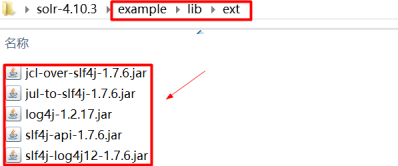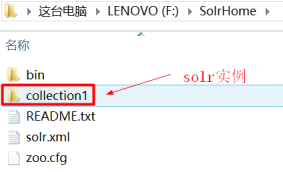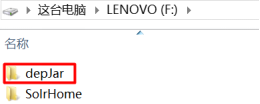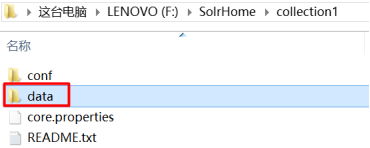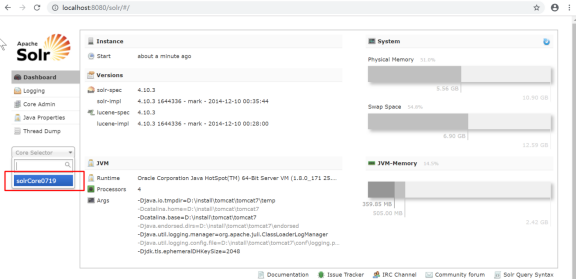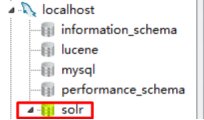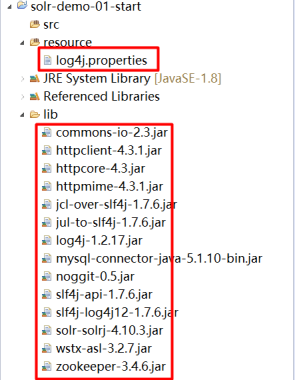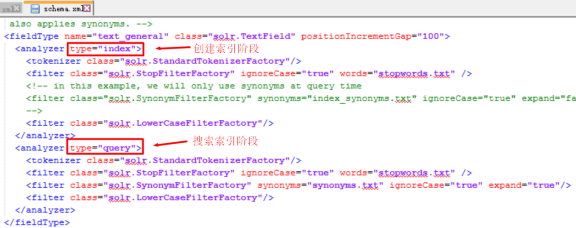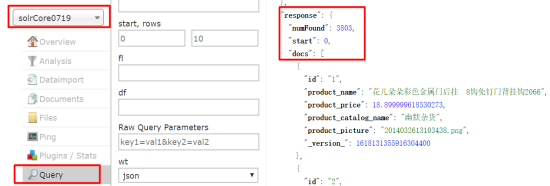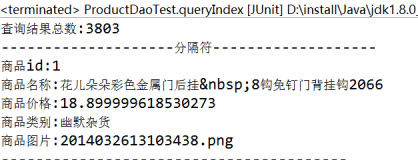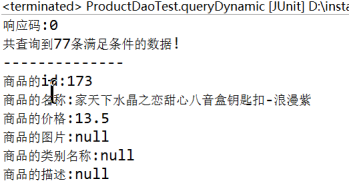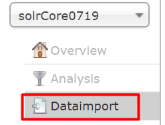Solr介绍 入门练习
1.1 Solr是什么
Solr是一个基于全文检索的企业级应用服务器。
全文检索:可以输入一段文字,通过分词检索数据!!(复习)
应用服务器:它是单独的服务。
1.2 Solr能做什么
它就是用于做全文搜索。
1.3 为什么需要Solr
问题:我们已经学过Lucene,为什么还要学习solr?
答:Lucene是一个工具包,不能单独运行,需要导入到java代码中。
Solr可以独立运行在tomcat容器中,通过http协议,以接口的方式对外提供服务,java代码只需要专注于业务的处理就可以。

1.4 Solr下载路径
http://archive.apache.org/dist/lucene/solr/
solr是基于lucene实现的,和Lucene同步更新。
1.5 Solr目录结构说明
下载solr-4.10.3.zip并解压:

bin:solr的运行脚本
contrib:solr的一些扩展jar包,用于增强solr的功能。
dist:该目录包含build过程中产生的war和jar文件,以及相关的依赖文件。
docs:solr的API文档
example:solr工程的例子目录:
licenses:solr相关的一些许可信息
2 入门示例
2.1 需求
使用Solr实现电商网站的商品搜索功能。
2.2 配置步骤说明
(1)配置Solr服务器。
(2)配置SolrHome。(Solr服务的主目录,磁盘)
(3)在Solr服务器中加载SolrHome。
(4)java程序访问Solr服务器,实现全文搜索。
2.3 配置步骤
2.4 第一部分:配置Solr服务器
--说明:Solr可以独立运行,需要servlet容器加载它。本文使用tomcat。
2.4.1 第一步:解压一个Tomcat
解压一个新的Tomcat,专门用来加载Solr。
|
|
2.4.2 第二步:部署Solr服务到Tomcat中
--在Solr的下载包中,提供了Solr的war包程序。(空的war包程序)
|
|
--拷贝solr.war到Tomcat的webapp目录下。并解压
|
|
2.4.3 第三步:添加Solr运行依赖的jar包
--在Solr的下载包中,提供Solr服务器运行所依赖的jar包。
|
|
(1)拷贝/example/lib/ext下的所有包,到solr应用的lib目录中
|
|
(2)拷贝/example/resource/log4j.properties,到solr应用的classes目录下。
--前提:先在/WEB-INF/目录下,创建classes目录。
|
|
2.5 第二部分:配置SolrHome
--说明:Solr的下载包中,提供了标准的SolrHome配置。
|
|
2.5.1 第一步:拷贝到本地,修改名称为SolrHome。(见名知意)
|
|
2.5.1.1 SolrHome说明
--SolrHome目录结构:
|
|
(1)SolrHome是Solr配置搜索服务的主目录。
(2)collection1称为Solr服务的一个实例(solrCore)。
(3)一个solr实例对应一个索引库。
(4)Solr可以同时配置多个实例。以便为不同的java程序提供搜索服务。
配置solr服务,就是在配置solr实例。
2.5.2 第二步:配置SolrCore
2.5.2.1 Step1:配置SolrCore实例的名称
--说明:每一个实例都有自己的名称。在core.properties文件中配置
|
|
--在这里,我们将其修改为:soreCore0719
|
|
2.5.2.2 Step2:配置SolrCore所需的jar依赖
--说明:Solr下载包中,提供SolrCore所需要的所有jar依赖。
|
|
(1)在SolrHome同级目录下,创建depJar文件夹。(目的:方便管理jar依赖)
|
|
(2)拷贝contrib、dist两个目录到depJar目录下。
|
|
(3)修改/collection1/conf目录下的solrconfig.xml,加载jar包
--说明:solr是通过<lib>标签,来加载运行所需要的jar包的。
|
|
(4)配置索引库目录
--说明:solr是通过<dataDir>标签,来指定索引库的目录的。
|
|
--默认路径是在SolrCore目录下,跟conf目录同级。首次加载时,将自动创建。
|
|
本课程就使用该默认路径。
2.6 第三部分:在Solr服务器中加载SolrHome
2.6.1 第一步:修改web.xml加载SolrHome
--在solr的应用中,是通过web.xml来加载SolrHome的。
|
|
--说明:在这里是通过修改<env-entry>标签,来加载SolrHome的。
|
|
2.6.2 第二步:启动Tomcat测试
--访问地址 http://localhost:8080/solr
|
|
--solr服务器配置成功!!!
2.7 第四部分:创建java程序访问solr服务器
--前提:创建好了数据库。(导入products-solr.sql文件即可)
|
|
--配置步骤说明:
(1)创建项目。
(2)创建索引
(3)搜索索引
2.7.1 第一步:创建项目,导入jar包
--导包说明:
|
SolrJ核心包 /solr-4.10.3/dist/solr-solrj-4.10.3.jar SolrJ依赖包 /solr-4.10.3/dist/solrj-lib下的所有包 日志依赖包 /solr-4.10.3/example/lib/ext目录下的所有jar包 JDBC驱动包 mysql-connector-java-5.1.10-bin.jar |
--拷贝log4j.properties到src目录下。(或者创建一个Source Folder)
--项目结构:
|
|
2.7.2 第二步:创建索引
--步骤说明。(复习回顾)
(1)采集数据。
(2)将数据转换成Solr文档。
(3)连接solr服务器,将文档写入索引库。
2.7.2.1 Step1:采集数据
--需求采集的字段说明:
参与搜索的字段:名称、价格、商品类别、描述信息
参与结果展示的字段:商品id、图片、
(1)创建Product类
|
public class Product {
private Integer pid;
private String name;
private String catalog_name;
private double price;
private String description;
private String picture;
// 补全get、set方法 } |
(2)创建ProductDao类
|
package cn.gzsxt.solr.dao;
import java.sql.Connection; import java.sql.DriverManager; import java.sql.PreparedStatement; import java.sql.ResultSet; import java.sql.SQLException; import java.util.ArrayList; import java.util.List;
import cn.gzsxt.solr.pojo.Product;
public class ProductDao {
private Connection connection; private PreparedStatement pst; private ResultSet rs;
/** * 采集数据,查询所有商品 * @return */ public List<Product> getAllProducts() {
List<Product> products = new ArrayList<>();
try {
//1、加载驱动 Class.forName("com.mysql.jdbc.Driver"); //2、获取Connection连接 connection = DriverManager.getConnection("jdbc:mysql://localhost:3306/solr", "root", "gzsxt"); //3、获取PreparedStatement,执行预编译 pst = connection.prepareStatement("select pid,name, catalog_name,price,description,picture from products"); //4、执行sql搜索 rs = pst.executeQuery();
Product p = null; while(rs.next()){ p = new Product(); p.setPid(rs.getInt("pid")); p.setName(rs.getString("name")); p.setPrice(rs.getFloat("price")); p.setPicture(rs.getString("picture")); p.setDescription(rs.getString("description")); p.setCatalog_name(rs.getString("catalog_name"));
products.add(p); }
} catch (Exception e) { e.printStackTrace(); }finally { if(null!=rs){ try { rs.close(); } catch (SQLException e) { // TODO Auto-generated catch block e.printStackTrace(); } } if(null!=pst){ try { pst.close(); } catch (SQLException e) { // TODO Auto-generated catch block e.printStackTrace(); } } if(null!=connection){ try { connection.close(); } catch (SQLException e) { // TODO Auto-generated catch block e.printStackTrace(); } } }
return products; }
}
|
(3)创建一个测试类ProductDaoTest
--导入junit类库。(快捷键ctrl+1)
|
package cn.gzsxt.solr.test;
import org.junit.Test;
import cn.gzsxt.solr.dao.ProductDao;
public class ProductDaoTest {
@Test public void getAllProducts(){ ProductDao dao = new ProductDao(); System.out.println(dao.getAllProducts()); } } |
--测试结果,采集数据成功!!!
|
|
2.7.2.2 Step2:将数据转换成Solr文档SolrInputDocument
--说明:solr是通过SolrInputDocument来封装数据的。部分源码如下:
|
public SolrInputDocument(Map fields){ _documentBoost = 1.0F; _fields = fields; }
public void addField(String name, Object value){ addField(name, value, 1.0F); } |
问题:我们在Lucene中知道,域有三大属性,在创建文档的时候指定。而Solr的源码中,只是用一个Map集合来封装域的信息。那域的三大属性怎么定义呢?
答:Solr是通过一个配置文件schema.xml,事先定义域的信息的。
2.7.2.2.1 Solr域的说明
--通过<field>标签定义域的名称等信息
|
|
name属性:域的名称
type属性: 域的类型(<FieldType>标签,加载了分词器,指定了分词属性)
indexed属性:是否索引
stored属性:是否存储
multiValued属性:是否支持多个值
--通过<fieldType>标签,定义域的类型信息
|
|
name属性:域类型的名称
class属性:指定域类型的solr类型。
<analyzer>:指定分词器。
<analyzer type=”index”>:表示在创建索引时,对域做分词处理。
<analyzer type=”query”>:表示在检索索引时,对域做分词处理。
<tokenizer>标签:指定分词器
<filter>标签:指定过滤器
2.7.2.2.2 Solr域的特点
(1)、Solr的域必须先定义,后使用。(否则报错:unknown fieldName)
(2)、定义solr域的时候,必须指定是否索引、是否存储这两个属性。<field>
(3)、定义solr域的时候,必须指定域的类型<fieldType>:
因为域的类型确定了这个域在索引、搜索两个阶段的分词属性。
<field>标签: 来指定索引、存储两个属性
<fieldType>标签:来指定分词属性
(4)、每一个文档中,必须包含id这个域,它的值标记文档的唯一性。
|
|
2.7.2.2.3 配置Solr业务域
--商品各字段属性说明
|
域 |
Tokened |
Indexed |
Stored |
|
商品的id |
N |
Y |
Y |
|
商品的名称 |
Y |
Y |
Y |
|
商品的类别 |
N |
Y |
Y |
|
商品的价格 |
Y |
Y |
Y |
|
商品的图片 |
N |
N |
Y |
|
商品描述信息 |
Y |
Y |
N |
--修改schema.xml,添加如下配置。(id域不用配置,直接使用solr的id域)
|
<!--product--> <field name="id" type="string" indexed="true" stored="true" required="true" multiValued="false" /> <field name="product_name" type="text_general" indexed="true" stored="true"/> <field name="product_catalog_name" type="string" indexed="true" stored="true" /> <field name="product_price" type="double" indexed="true" stored="true"/> <field name="product_description" type="text_general" indexed="true" stored="false" /> <field name="product_picture" type="string" indexed="false" stored="true" /> |
2.7.2.2.4 修改ProductDao,新增getDocuments方法
|
/** * 将采集到的商品数据,转换成solr文档类型 * @param products * @return */ public List<SolrInputDocument> getDocuments(List<Product> products){ List<SolrInputDocument> docs = new ArrayList<>(); SolrInputDocument doc = null; for (Product product : products) { doc = new SolrInputDocument(); doc.addField("id", product.getPid()); doc.addField("product_name", product.getName()); doc.addField("product_price", product.getPrice()); doc.addField("product_catalog_name", product.getCatalog_name()); doc.addField("product_description", product.getDescription()); doc.addField("product_picture", product.getPicture());
docs.add(doc); }
return docs; } |
2.7.2.3 Step3:连接Solr服务器,创建索引
--前提:已经启动了Tomcat,加载了Solr服务器。(前面给过schema.xml,需要重写启动Tomcat)
--修改ProductDaoTest类,新增createIndex方法
|
@Test public void createIndex(){ // 1、 创建HttpSolrServer对象,通过它和Solr服务器建立连接。 // 参数:solr服务器的访问地址 HttpSolrServer server = new HttpSolrServer("http://localhost:8080/solr/solrCore0719"); // 2、 通过HttpSolrServer对象将SolrInputDocument添加到索引库。 ProductDao dao = new ProductDao(); try { server.add(dao.getDocuments(dao.getAllProducts())); // 3、 提交。 server.commit(); System.out.println("创建索引库成功!!!");
} catch (SolrServerException e) { e.printStackTrace(); } catch (IOException e) { e.printStackTrace(); } } |
2.7.2.4 Step4:访问Solr主界面,在Query选项下测试
|
|
--创建索引库成功!!!
2.7.3 第三步:搜索索引
--修改ProductDaoTest类型,新增一个查询方法
|
@Test public void queryIndex() throws Exception { // 创建HttpSolrServer对象,通过它和Solr服务器建立连接。 // 参数:solr服务器的访问地址 HttpSolrServer server = new HttpSolrServer("http://localhost:8080/solr/solrCore0719");
// 创建SolrQuery对象 SolrQuery query = new SolrQuery(); // 设置查询条件,参考主界面 query.set("q", "*:*");
// 调用server的查询方法,查询索引库 QueryResponse response = server.query(query);
// 查询结果 SolrDocumentList results = response.getResults();
// 查询结果总数 long cnt = results.getNumFound(); System.out.println("查询结果总数:" + cnt);
System.out.println("--------------------分隔符-------------------");
for (SolrDocument solrDocument : results) { System.out.println("商品id:"+solrDocument.get("id")); System.out.println("商品名称:"+solrDocument.get("product_name")); System.out.println("商品价格:"+solrDocument.get("product_price")); System.out.println("商品类别:"+solrDocument.get("product_catalog_name")); System.out.println("商品图片:"+solrDocument.get("product_picture"));
System.out.println("----------------------------------------"); } } |
--查询结果,非常成功!!!
|
|
3 solr管理控制台
3.1 查询界面说明
|
|
(1) q - 查询关键字,必须,如果查询所有文档时,使用*:*。
|
|
(2) fq - (filter query)过虑查询,可以有多个。如:价格10到50的记录。
|
|
(3) sort - 排序,格式:sort=<field name>+<desc|asc>。如:按价格升序
|
|
(4) start - 分页显示使用,开始记录下标,从0开始
|
|
(5) rows - 指定返回结果最多有多少条记录,配合start来实现分页。
|
|
(6) fl - 指定返回那些字段内容,用逗号或空格分隔多个。
|
|
(7) df-指定一个默认搜索的Field
|
|
(8) wt - (writer type)指定输出格式,默认json格式。
|
|
3.1.1 对照界面,实现复杂查询
--修改ProductDaoTest类型,新增动态查询方法
|
@Test public void queryDynamic(){ //1、连接solr服务器 HttpSolrServer server = new HttpSolrServer("http://localhost:8080/solr/solrCore0719");
//2、创建查询对象,封装查询条件 SolrQuery query = new SolrQuery(); //设置默认搜索的域 query.set("df", "product_name");
//参考管理界面中的 "q"标签,封装查询的关键词 query.set("q", "音乐盒");
//添加价格过滤 query.addFilterQuery("product_price:[10 TO 50]"); //添加类别过滤 query.addFilterQuery("product_catalog_name:幽默杂货");
//设置排序 价格升序 query.set("sort","product_price asc");
//设置分页信息 第二页 每页10条 start=(page-1)*pageSize query.set("start", 10); query.set("rows",10);
//设置要查询字段 query.set("fl", "id,product_name,product_price");
//3、执行查询 try { QueryResponse response = server.query(query);
//获取查询的响应码 int status = response.getStatus(); System.out.println("响应码:"+status);
if(0==status){ SolrDocumentList solrDocumentList = response.getResults();
long numFound = solrDocumentList.getNumFound(); System.out.println("共查询到"+numFound+"条满足条件的数据!"); System.out.println("--------------"); for (SolrDocument s : solrDocumentList) { System.out.println("商品的id:"+s.get("id")); System.out.println("商品的名称:"+s.get("product_name")); System.out.println("商品的价格:"+s.get("product_price")); System.out.println("商品的图片:"+s.get("product_picture")); System.out.println("商品的类别名称:"+s.get("product_catalog_name")); System.out.println("商品的描述:"+s.get("product_decsription")); System.out.println("-----------分隔符---------------"); }
}
} catch (SolrServerException e) {
e.printStackTrace(); } } |
--测试结果:非常成功!!!(对比管理界面查询结果)
|
|
3.2 安装DataImport插件
3.2.1 Dataimport插件说明
--好处:可以在管理界面直接从数据库导入数据到索引库。(即:一个插件解决入门示例中,创建索引的全部操作)
|
|
3.2.2 安装步骤
3.2.2.1 第一步:添加jar依赖
(1)将/solr-4.10.3/dist/solr-dataimporthandler-4.10.3.jar拷贝到
/depJar/contrib/dataimporthandler/lib目录下
|
|
(2)、将jdbc驱动包拷贝到 /depJar/contrib/db/lib 目录下
|
|
(3)、在solrconfig.xml文件中,加载这两个jar依赖
|
<lib dir="F:/depJar/contrib/dataimporthandler/lib/" regex=".*\.jar" /> <lib dir="F:/depJar/contrib/db/lib/" regex=".*\.jar" /> |
3.2.2.2 第二步:配置数据库表和solr域的映射关系
--在solr实例的conf目录下,配置数据库映射文件data-config.xml
|
<?xml version="1.0" encoding="UTF-8" ?> <dataConfig> <dataSource type="JdbcDataSource" driver="com.mysql.jdbc.Driver" url="jdbc:mysql://localhost:3306/solr" user="root" password="gzsxt"/> <document> <entity name="product" query="SELECT pid,name,catalog,catalog_name,price,description,picture FROM products "> <field column="pid" name="id"/> <field column="name" name="product_name"/> <field column="catalog_name" name="product_catalog_name"/> <field column="price" name="product_price"/> <field column="description" name="product_description"/> <field column="picture" name="product_picture"/> </entity> </document> </dataConfig> |
3.2.2.3 第三步:创建dataimport处理器
--说明:Solr是在solrconfig.xml文件中,通过<requestHandler>标签定义各类请求处理器
--修改solrconfig.xml,添加如下配置。(加载data-config.xml映射文件)
|
<requestHandler name="/dataimport" class="org.apache.solr.handler.dataimport.DataImportHandler"> <lst name="defaults"> <str name="config">data-config.xml</str> </lst> </requestHandler> |
3.2.2.4 第四步:重启tomcat,在管理界面测试
--测试清空索引库,成功!!!
|
|
--测试重新导入数据,成功!!!
|
|
3.3 Analyzer分析器,配置中文分词器
3.3.1 Solr自带分词器的缺陷
--solr跟Lucene一样,提供了很多分析器。可以在Analyzer选型下测试分词效果。
|
|
--测试发现:所以的分词器,对中文支持都不友好。
解决办法:配置中文分词器。
3.3.2 Solr配置中文分析器
3.3.2.1 中文分析器选择
选择IK中文分词器。
3.3.2.2 配置步骤
3.3.2.2.1 第一步:添加IkAnalyze的jar依赖
--把IKAnalyzer2012FF_u1.jar添加到solr/WEB-INF/lib目录下。
3.3.2.2.2 第二步:加载IkAnalyzer的核心配置文件
--拷贝IkAnalyzer的配置文件到solr/WEB-INF/classes目录
|
|
3.3.2.2.3 第三步:创建中文分词器
--在schema.xml中自定义一个FieldType,指定中文分词器IKAnalyzer。
|
<!-- IKAnalyzer--> <fieldType name="text_ik" class="solr.TextField"> <analyzer class="org.wltea.analyzer.lucene.IKAnalyzer"/> </fieldType> |
3.3.2.3 测试中文分词器
3.3.2.3.1 第一步:重启tomcat
3.3.2.3.2 第二步:在analysis选项卡下,测试分词效果。成功!!!
|
|
3.3.3 改造业务域,使用IK做分词器
--修改schem.xml文件,修改需要分词的域的fieldType类型
我们只需要修改product_name、product_description两个业务域即可。
|
<field name="id" type="string" indexed="true" stored="true" required="true" multiValued="false" />
<field name="product_name" type="text_ik" indexed="true" stored="true"/> <field name="product_catalog_name" type="string" indexed="true" stored="true" /> <field name="product_price" type="double" indexed="true" stored="true"/> <field name="product_description" type="text_ik" indexed="true" stored="false" /> <field name="product_picture" type="string" indexed="false" stored="true" /> |
--重启tomcat即可。




